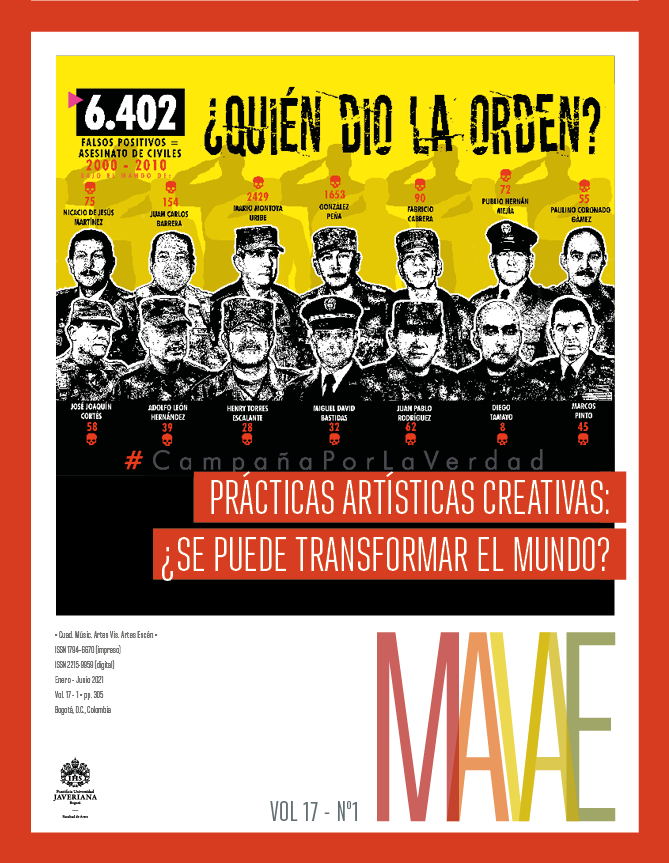Resumo
Este artigo é baseado em um projeto de pesquisa + criação desenvolvido na Universidade de San Buenaventura em Medellin, que se realiza no atual contexto social, político e artístico, no qual manifestações sociais e culturais emergiram com evidente relevância, com poucos antecedentes em nossa sociedade colombiana. Corpos bélicos é uma performance realizada em Medellin durante os anos de 2019 e 2020, e apresentada na VII Bienal Internacional de Performance (Bogotá, 2021), na qual um artista caminha pela rua usando máscaras de guerra como um ato subversivo diante do uma situação de conflito. Tem como objetivo mergulhar na arte da performance como ação transgressora do espaço público, refletir sobre o corpo como gerador de experiências sensíveis e discutir a linguagem da arte assumida como subversão da realidade. Esta aposta aborda a ação artística como metodologia para o debate sobre as fábulas de guerra, o corpo como potência criativa e a performance como possibilidade de assumir a guerra como modo de existência. Por fim, as conclusões são geradas diante das fabricações subversivas que o corpo pode criar no espaço social e político, a partir das representações de sua corporiedade, transformada pela linguagem simbólica da arte, por meio da figura filosófica da dobra.
Albarrán, Luis. 2019. Performance y arte contemporáneo: Discursos, prácticas, problemas. Madrid: Cátedra.
Arendt, Hannah. 1993. La condición humana. Barcelona: Paidós.
Cangi, Adrián. 2011. “Escribir el cuerpo: Indicios, querellas y variaciones”.
En M. Serres, Variaciones sobre el cuerpo, 9-26. Buenos Aires: Fondo de Cultura Económica.
Careri, Francesco. 2013. Walkscapes, el andar como práctica estética. Barcelona: Gustavo Gili.
Coccia, Emanuele. 2011. La vida sensible. Buenos Aires: Marea.
Deleuze, Gilles. 1989. El pliegue: Leibniz y el Barroco. Barcelona: Paidós.
Delgado, Manuel. 2006. El animal público: Hacia una antropología de los
espacios urbanos. Barcelona: Anagrama.
Fernández Vicente, Antonio y Manibardo Beltrán Almudena. 2015. “El
concepto de parresía: Verdad y libertad de palabra”. Razón y Palabra, n.º
: 1-18. https://dialnet.unirioja.es/servlet/articulo?codigo=5415568.
Garavito, Edgar. 1996. “Del uso mayor y menor de la guerra”. Nova y Vetera, n.º 23, 11-15.
Gómez Vélez, Alejandra. 2019. La imagen intermitente: Espera y contestación ante la presencia desnuda de lo otro. Medellín: Universidad Nacional de Colombia.
Le Breton, David. 2018. La sociología del cuerpo. Madrid: Siruela.
Machado Toro, María Cristina. 2021. Álvaro de Campos, un alma rebosante de mar. Medellín: Universidad Pontificia Bolivariana. https://repository.upb.edu.co/handle/20.500.11912/8788
Márquez Estrada, José Wilson. 2007. Gilles Deleuze-Michel Foucault: El
continente fascinante de la filosofía moderna. Cartagena: El Caribe. http://leopoldoranke.blogspot.com/2011/05/gilles-deleuze-michelfoucault-el_24.html.
Serres, Michel. 2011. Variaciones sobre el cuerpo. Buenos Aires: Fondo de Cultura Económica.
Sun Tzu. 2009. El arte de la guerra. Madrid: Planeta.
Taylor, Diana. 2011. “Introducción, performance, teoría y práctica”. En Marcela Fuentes, Estudios Avanzados de performance, 7-30. México: Fondo de Cultura Económica.
Zuleta, Estanislao. 2020. Colombia: Violencia, democracia y derechos humanos. Bogotá: Planeta.

Este trabalho está licenciado sob uma licença Creative Commons Attribution 4.0 International License.
Copyright (c) 2021 Maria Isabel Naranjo Cano


